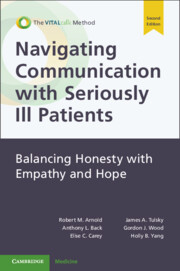Book contents
- Navigating Communication with Seriously Ill Patients
- Navigating Communication with Seriously Ill Patients
- Copyright page
- Dedication
- Reviews
- Contents
- Preface
- Acknowledgments
- 1 Taking Your Skills to the Next Level
- 2 Foundational Communication Skills
- 3 Talking about Serious News
- 4 Discussing Prognosis
- 5 Planning for the Future: Discussing What’s Important, Well Before a Crisis
- 6 Discussing Treatment Decisions
- 7 Between the Big Events
- 8 Goals of Care in Late-Stage Disease
- 9 Conducting a Family Conference
- 10 Dealing with Conflicts between Clinicians and Patients
- 11 Working Through Conflicts with Colleagues
- 12 When You’re Really Stuck
- 13 Talking about Dying
- 14 Cultivating Your Skills
- Index
- References
3 - Talking about Serious News
When the Emotional Channel Is On High
Published online by Cambridge University Press: 05 April 2024
- Navigating Communication with Seriously Ill Patients
- Navigating Communication with Seriously Ill Patients
- Copyright page
- Dedication
- Reviews
- Contents
- Preface
- Acknowledgments
- 1 Taking Your Skills to the Next Level
- 2 Foundational Communication Skills
- 3 Talking about Serious News
- 4 Discussing Prognosis
- 5 Planning for the Future: Discussing What’s Important, Well Before a Crisis
- 6 Discussing Treatment Decisions
- 7 Between the Big Events
- 8 Goals of Care in Late-Stage Disease
- 9 Conducting a Family Conference
- 10 Dealing with Conflicts between Clinicians and Patients
- 11 Working Through Conflicts with Colleagues
- 12 When You’re Really Stuck
- 13 Talking about Dying
- 14 Cultivating Your Skills
- Index
- References
Summary
The VitalTalk roadmap for talking about serious news is GUIDE (Get ready, Understand, Inform, Demonstrate empathy, and Equip patient for next steps). Getting ready includes planning the details of the meeting, including why and how the information is to be shared. The next step is understanding what the patient expects from the visit and what they have been told so far. Prior to giving information, the clinician should ask permission to share what they know. The news should be shared using a headline containing both data and what it means for the patient’s life. Afterwards, the clinician should demonstrate empathy by recognizing and responding to emotion. Equipping the patient includes discussing next steps, summarizing, and checking for shared understanding. There may also be challenges of patients receiving potentially too little or too much information when families say “don’t tell” or due to asynchronous electronic results delivery respectively. How much patients want to know and how and when they get information can be clarified through preparatory discussions. Finally, medical errors are another form of serious news that require an apology along with the headline.
- Type
- Chapter
- Information
- Navigating Communication with Seriously Ill PatientsBalancing Honesty with Empathy and Hope, pp. 36 - 51Publisher: Cambridge University PressPrint publication year: 2024



